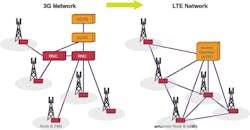I recently received a letter from Prabhu Soundarrajan, global director of applications and solutions for RAE Systems (a manufacturer of intelligent gas detection systems) asking about trends in cellular technology. He said he had read my article on the blurring boundaries between wireless and cellular technologies in industrial applications and wants to know more about coming changes affecting cellular in order to better direct RAE Systems’ plans.
“Our engineering team is planning for the next wave in cellular technology,” Soundarrajan wrote. “We currently have GPRS technology and want to know when it will become obsolete.” He also asked about which cellular technology would likely become more popular in the U.S., China and Europe by 2016.
To get a solid answer on this topic, I turned to Steven Toteda, chairman of WINA (Wireless Industrial Networking Alliance) and vice president and general manager of Cooper Bussman. Toteda says that GPRS technology is essentially a cellular dial-up modem, much like the old dial-up modems used before DSL and cable modems became the standard. “They often call GPRS a 2.5G technology, since it represents the advent of a separate data connection from the voice call,” he adds.
The shift to 3G standards, Toteda explains, “provides a fundamental shift for operators to a full Internet Protocol packet-based network — one that operates far more efficiently for data, as well as for voice calls.” An example of this would be the ability to make calls on your smartphone while you access the Web on AT&T’s 3G network.
Since it is already becoming difficult to purchase GPRS modems as the technology fades out, Toteda says that Cooper Bussman is in the process of phasing out its own GPRS product in favor of the new 615M-1 3G cellular modem. He expects that, by 2016, carriers around the world will “make it very difficult to even connect into their network using GPRS modems, and some may have abandoned 2G/2.5G altogether. There certainly won’t be any economic incentive for 2G to still be around.”
Looking beyond the move from GPRS to 3G and into 4G, it is less clear at this point how that transition will occur. “Several operators and now using 4G terms as part of their marketing,” Toteda says, “so the answer as to which technology will become more popular is not easily answered by 4G versus 3G. However, there will be a convergence around the cellular standards to a global standard that uses WCDMA for the wireless coding and IPv6 protocols for the networking.”
Toteda adds that he is also beginning to see “the rollout of LTE (Long Term Evolution) by Verizon and AT&T, which used to operate very different networks. This LTE technology will become the one global standard over the next few years.”
LTE is often marketed as 4G LTE, and is seen by many to be the natural upgrade path for carriers using GSM/UMTS as well as CDMA (for which Verizon was well-known for using). The successful rollouts of LTE in Sweden, North America and Japan in last few years is leading many, including Toteda, to assert that LTE will soon be the global standard.
If all this seems a bit confusing, don’t feel bad; it’s confusing even to the experts right now. Toteda summed it up well saying, “Cellular technology is moving at a rate that is truly incredible … even for me!”
Bottom line: Your near-term planning should definitely focus on 3G. Unless something changes in the next year or two, your long-term planning should focus on LTE.
Leaders relevant to this article:


